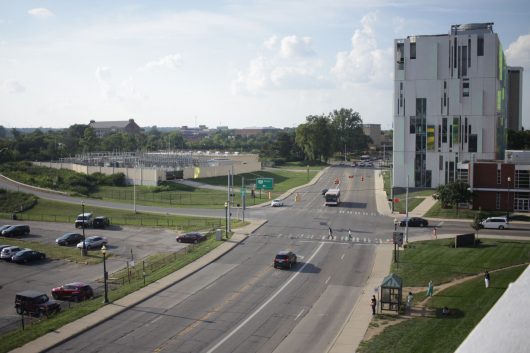Phase One of the Cannon Drive relocation plan is scheduled to start Sept. 5, and with the highly anticipated night football game against Oklahoma taking place days later on Sept. 9, parking and traffic disruptions are expected when over 100,000 fans flood the nearby Ohio Stadium.
This phase of the project will run from King Avenue to John Herrick Drive, Lynn Readey, the university’s associate vice president of facilities and operations, said Thursday at the Ohio State Board of Trustees Master Planning & Facilities meeting. During the meeting, members of the Board engaged in back-and-forth conversation on how this construction could affect football parking.
The construction is designed to raise the road to account for possible flooding, which Ohio State spokesman said has resulted in numerous flooding issues. The destruction of the Polo and Dodd parking lots during this phase will result in 2,100 parking spots lost, as well as numerous bus route and parking permit changes.
Jay Kasey, senior vice president of administration and planning at Ohio State, said there is a plan in place to handle gameday traffic.
Kasey said the Medical Center exit on state Route 315 North would still be open as usual on Saturdays, and those who usually park in the Polo Lot would be able to park in the 9thAvenue East Garage, while medical center employees who normally use that garage would be instructed to park in the 12th Avenue Garage on game days.
The Cannon Drive garages will remain open during construction, but only for medical center patients.
“We are hoping that (the Oklahoma game) will be as exciting as most night games, but not more so,” Kasey added as the Board collectively laughed.
Phase Two of the project, which starts at John Herrick Drive and goes to Woody Hayes Drive, is slated to start in July 2019 in order to start construction before football season starts. The total time for the relocation project to over three years by completion date.
Board member Robert Schottenstein said starting in March or April could save “millions” when it comes to landscaping.
“We should try to do what we can with Phase Two so that we can accelerate certain things so that we start moving dirt in March or April,” Schottenstein said. “Because depending on weather a whole lot of work can get done in that spring, summer and early fall and if we start mid-summer we’ve lost the best growing season, it just doesn’t make sense.”
Kasey said the start of Phase Two will be highly dependent on the demolition of the Drake Performance Center, which will in turn be dependent on replacing the functions of the Drake before demolishing it. Kasey, however, said detailed plans for Phase Two were not available at this time but that he would share them at future meetings.
Also of concern to the Board was the cost of the project, and in particular monetary contributions from those outside the university, namely the city of Columbus and the newly formed Ohio State Energy Partners.
Readey told the Board that the large 22-month project’s total cost would be $51.6 million. The project is, however, currently “yellow-lighted” for cost and time, meaning that both are being closely watched to keep them on track.
Readey informed the Board that the city would be contributing $18.3 million — a fixed amount — in the form of a grant agreement. Readey said the figure came from the city’s desire to pay for 50 percent of the cost to raise Cannon Drive, which amounted to $18.3 million in early estimates.
The other contributor mentioned was Ohio State Energy Partners which will pay for the cost of utilities in the project, which based on early estimates will come to $4 million.



